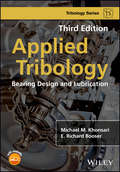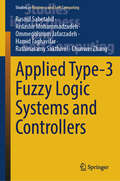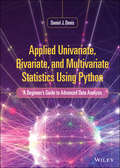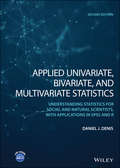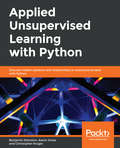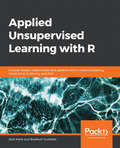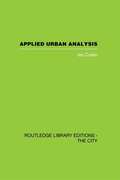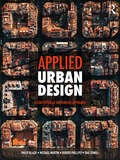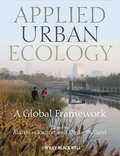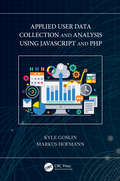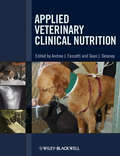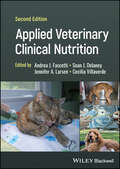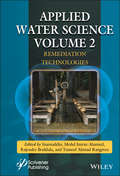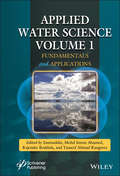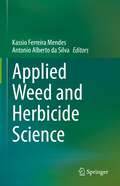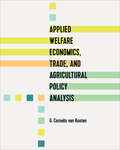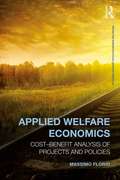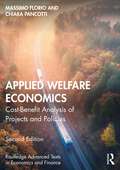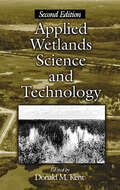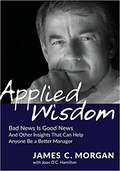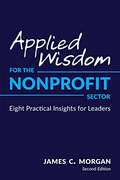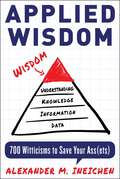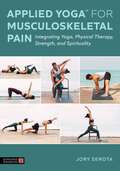- Table View
- List View
Applied Tribology: Bearing Design and Lubrication
by E. Richard Booser Michael M. KhonsariApplications of tribological technology in bearings are wide and varied in industries ranging from aerospace, marine and automotive to power, process, petrochemical and construction. Applied Tribology, 2nd edition not only covers tribology in bearings but demonstrates the same principles for other machine components, such as piston pins, piston rings and hydrostatic lifts, as well as in more recent technologies such as gas bearings in high-speed machines and computer read-write devices. Maintaining a balance between theoretical analysis and practical experience with co-authors from academia and industry, this new edition is significantly revised and expanded with new material. Features include; - Two brand new chapters on seals and bearing failure modes and bearing health monitoring techniques- Coverage of new developments in full-film, dry, and partial lubrication; gas bearings; and ball and roller bearings- Design guides based on full Reynolds equation that enable accurate prediction of load capacity, power loss, temperature rise- Comprehensive presentation of important design factors involving material and lubricants. - State-of-the-art presentation and up-to-date references of pertinent scientific and applied topics in tribology- Numerous examples that reinforce the understanding of concepts and provide procedures for the design and performance analysis of components Applied Tribology, 2nd edition provides a valuable and authoritative resource for mechanical engineering professionals working in a wide range of industries with machinery including turbines, compressors, motors, electrical appliances & electronic components. Senior and graduate students in mechanical engineering will also find it a useful text and reference.
Applied Type-3 Fuzzy Logic Systems and Controllers (Studies in Fuzziness and Soft Computing #417)
by Hamid Taghavifar Chunwei Zhang Rathinasamy Sakthivel Ardashir Mohammadzadeh Rasoul Sabetahd Ommegolsoum JafarzadehThis book provides the fundamental approaches to designing and using type-3 fuzzy systems in real-world applications. Basic Matlab codes are provided to use type-3 fuzzy systems in a straightforward scheme. The main differences between type-3 fuzzy systems and other types are analyzed and compared. The effectiveness of type-3 fuzzy systems is analyzed and studied in various applications, such as robotics, intelligent control systems, and data science.
Applied Univariate, Bivariate and Multivariate Statistics
by Daniel J. DenisA clear and efficient balance between theory and application of statistical modeling techniques in the social and behavioral sciences Written as a general and accessible introduction, Applied Univariate, Bivariate, and Multivariate Statistics provides an overview of statistical modeling techniques used in fields in the social and behavioral sciences. Blending statistical theory and methodology, the book surveys both the technical and theoretical aspects of good data analysis. Featuring applied resources at various levels, the book includes statistical techniques such as t-tests and correlation as well as more advanced procedures such as MANOVA, factor analysis, and structural equation modeling. To promote a more in-depth interpretation of statistical techniques across the sciences, the book surveys some of the technical arguments underlying formulas and equations. Applied Univariate, Bivariate, and Multivariate Statistics also features Demonstrations of statistical techniques using software packages such as R and SPSS® Examples of hypothetical and real data with subsequent statistical analyses Historical and philosophical insights into many of the techniques used in modern social science A companion website that includes further instructional details, additional data sets, solutions to selected exercises, and multiple programming options An ideal textbook for courses in statistics and methodology at the upper-undergraduate and graduate-levels in psychology, political science, biology, sociology, education, economics, communications, law, and survey research, Applied Univariate, Bivariate, and Multivariate Statistics is also a useful reference for practitioners and researchers in their field of application.
Applied Univariate, Bivariate, and Multivariate Statistics Using Python: A Beginner's Guide to Advanced Data Analysis
by Daniel J. DenisApplied Univariate, Bivariate, and Multivariate Statistics Using Python A practical, “how-to” reference for anyone performing essential statistical analyses and data management tasks in PythonApplied Univariate, Bivariate, and Multivariate Statistics Using Python delivers a comprehensive introduction to a wide range of statistical methods performed using Python in a single, one-stop reference. The book contains user-friendly guidance and instructions on using Python to run a variety of statistical procedures without getting bogged down in unnecessary theory. Throughout, the author emphasizes a set of computational tools used in the discovery of empirical patterns, as well as several popular statistical analyses and data management tasks that can be immediately applied.Most of the datasets used in the book are small enough to be easily entered into Python manually, though they can also be downloaded for free from www.datapsyc.com. Only minimal knowledge of statistics is assumed, making the book perfect for those seeking an easily accessible toolkit for statistical analysis with Python. Applied Univariate, Bivariate, and Multivariate Statistics Using Python represents the fastest way to learn how to analyze data with Python.Readers will also benefit from the inclusion of:A review of essential statistical principles, including types of data, measurement, significance tests, significance levels, and type I and type II errorsAn introduction to Python, exploring how to communicate with PythonA treatment of exploratory data analysis, basic statistics and visual displays, including frequencies and descriptives, q-q plots, box-and-whisker plots, and data managementAn introduction to topics such as ANOVA, MANOVA and discriminant analysis, regression, principal components analysis, factor analysis, cluster analysis, among others, exploring the nature of what these techniques can vs. cannot do on a methodological levelPerfect for undergraduate and graduate students in the social, behavioral, and natural sciences, Applied Univariate, Bivariate, and Multivariate Statistics Using Python will also earn a place in the libraries of researchers and data analysts seeking a quick go-to resource for univariate, bivariate, and multivariate analysis in Python.
Applied Univariate, Bivariate, and Multivariate Statistics: Understanding Statistics for Social and Natural Scientists, With Applications in SPSS and R
by Daniel J. DenisAN UPDATED GUIDE TO STATISTICAL MODELING TECHNIQUES USED IN THE SOCIAL AND BEHAVIORAL SCIENCES The revised and updated second edition of Applied Univariate, Bivariate, and Multivariate Statistics: Understanding Statistics for Social and Natural Scientists, with Applications in SPSS and R contains an accessible introduction to statistical modeling techniques commonly used in the social and behavioral sciences. The text offers a blend of statistical theory and methodology and reviews both the technical and theoretical aspects of good data analysis. Featuring applied resources at various levels, the book includes statistical techniques using software packages such as R and SPSS®. To promote a more in-depth interpretation of statistical techniques across the sciences, the book surveys some of the technical arguments underlying formulas and equations. The thoroughly updated edition includes new chapters on nonparametric statistics and multidimensional scaling, and expanded coverage of time series models. The second edition has been designed to be more approachable by minimizing theoretical or technical jargon and maximizing conceptual understanding with easy-to-apply software examples. This important text: Offers demonstrations of statistical techniques using software packages such as R and SPSS® Contains examples of hypothetical and real data with statistical analyses Provides historical and philosophical insights into many of the techniques used in modern social science Includes a companion website that includes further instructional details, additional data sets, solutions to selected exercises, and multiple programming options Written for students of social and applied sciences, Applied Univariate, Bivariate, and Multivariate Statistics, Second Edition offers a text to statistical modeling techniques used in social and behavioral sciences.
Applied Unsupervised Learning with Python: Discover hidden patterns and relationships in unstructured data with Python
by Benjamin Johnston Aaron Jones Christopher KrugerDesign clever algorithms that can uncover interesting structures and hidden relationships in unstructured, unlabeled dataKey FeaturesLearn how to select the most suitable Python library to solve your problemCompare k-Nearest Neighbor (k-NN) and non-parametric methods and decide when to use themDelve into the applications of neural networks using real-world datasetsBook DescriptionUnsupervised learning is a useful and practical solution in situations where labeled data is not available. Applied Unsupervised Learning with Python guides you on the best practices for using unsupervised learning techniques in tandem with Python libraries and extracting meaningful information from unstructured data. The course begins by explaining how basic clustering works to find similar data points in a set. Once you are well versed with the k-means algorithm and how it operates, you’ll learn what dimensionality reduction is and where to apply it. As you progress, you’ll learn various neural network techniques and how they can improve your model. While studying the applications of unsupervised learning, you will also understand how to mine topics that are trending on Twitter and Facebook and build a news recommendation engine for users. You will complete the course by challenging yourself through various interesting activities such as performing a Market Basket Analysis and identifying relationships between different merchandises. By the end of this course, you will have the skills you need to confidently build your own models using Python.What you will learnUnderstand the basics and importance of clusteringBuild k-means, hierarchical, and DBSCAN clustering algorithms from scratch with built-in packagesExplore dimensionality reduction and its applicationsUse scikit-learn (sklearn) to implement and analyse principal component analysis (PCA)on the Iris datasetEmploy Keras to build autoencoder models for the CIFAR-10 datasetApply the Apriori algorithm with machine learning extensions (Mlxtend) to study transaction dataWho this book is forThis course is designed for developers, data scientists, and machine learning enthusiasts who are interested in unsupervised learning. Some familiarity with Python programming along with basic knowledge of mathematical concepts including exponents, square roots, means, and medians will be beneficial.
Applied Unsupervised Learning with R
by Bradford TuckfieldApplied Unsupervised Learning with R is designed for business professionals, who want to learn about methods to understand their data better, and developers, who have an interest in unsupervised learning. It'll help you to have basic, beginner-level familiarity with R, including how to open the R console, how to read data, and how to create a loop. To easily understand the concepts of this book, you should know basic mathematical concepts, such as exponents, square roots, means, and medians.
Applied Urban Analysis: A critique and synthesis
by Ian CullenMuch of the theoretical literature in planning and human geography at present is materialist in perspective. This offers a powerful critique but locates the dynamics of urban systems too specifically in just one basic social relationship. It fails to provide an intellectual base broad enough for constructive, detailed urban analysis, partly because it fails to do justice to the reflective awareness of the individual. The alternative humanist position redresses the balance in favour of the individual but again cannot serve the practical requirements of urban analysis since it so often ignores social or contextual analysis. Ian Cullen synthesizes these tow apparently inconsistent theoretical positions and to render the increasingly obscure debate between them accessible. This book was first published in 1984.
Applied Urban Design: A Contextually Responsive Approach
by Michael Martin Robert Phillips Philip Black Taki SonbliApplied Urban Design combines 'why' we design and 'who' we design for, with 'how' we design, by providing the reader with a comprehensive and accessible bespoke framework for both understanding and practicing urban design in a contextually responsive manner from appraisal to design delivery. The framework is presented across four distinct steps, covering analysis at strategic and local scales; the urban design program; design development; and technical design. The authors unpack the functional blueprints, liveable qualities, contextual dynamics, and technical components of quality urban design, identifying the role of urban designers in shaping spaces and places across differing local contexts through a responsive and multiscalar approach. International best practice examples and two original ‘live’ case studies in Aalborg, Denmark and Manchester, UK demonstrate the application of the framework across differing scales and contexts – each supported by authors own images and graphics that illustrate the broad range of urban design visualisation techniques and methods.Visually compelling and insightful, Applied Urban Design is for all who seek to understand, demand, and create people-centred, high-quality, contextually responsive places and spaces.
Applied Urban Ecology: A Global Framework
by Matthias Richter Ulrike WeilandApplied Urban Ecology: A Global Framework explores ways in which the environmental quality of urban areas can be improved starting with existing environmental conditions and their dynamics. Written by an internationally renowned selection of scientists and practitioners, the book covers a broad range of established and novel approaches to applied urban ecology. Approaches chosen for the book are placed in the context of issues such as climate change, green- and open-space development, flood-risk assessment, threats to urban biodiversity, and increasing environmental pollution (especially in the “megacities” of newly industrialized countries). All topics covered were chosen because they are socially and socio-politically relevant today. Further topics covered include sustainable energy and budget management, urban water resource management, urban land management, and urban landscape planning and design. Throughout the book, concepts and methods are illustrated using case studies from around the world. A closing synopsis draws conclusions on how the findings of urban ecological research can be used in strategic urban management in the future. Applied Urban Ecology: A Global Framework is an advanced textbook for students, researchers and experienced practitioners in urban ecology and urban environmental research, planning, and practice.
Applied User Data Collection and Analysis Using JavaScript and PHP
by Markus Hofmann Kyle GoslinApplied User Data Collection and Analysis Using JavaScript and PHP is designed to provide the technical skills and competency to gather a wide range of user data from web applications in both active and passive methods. This is done by providing the reader with real-world examples of how a variety of different JavaScript- and PHP-based libraries can be used to gather data using custom feedback forms and embedded data gathering tools. Once data has been gathered, this book explores the process of working with numerical data, text analysis, visualization approaches, statistics, and rolling out developed applications to both data analysts and users alike.Using the collected data, this book aims to provide a deeper understanding of user behavior and interests, allowing application developers to further enhance web-application development. Key Features: Complete real-world examples of gathering data from users and web environments Offers readers the fundamentals of text analysis using JavaScript and PHP Allows the user to understand and harness JavaScript data-visualization tools Integration of new and existing data sources into a single, bespoke web-based analysis environment
Applied Veterinary Clinical Nutrition
by Andrea J. Fascetti Sean J. DelaneyApplied Veterinary Clinical Nutrition provides current, clinically relevant nutritional advice intended for use in daily canine and feline practice. Highly practical, the book emphasizes solutions for integrating nutrition into clinical practice, with introductory chapters covering the foundation and science behind the recommendations and extensive references for further reading. Written by a group of leading veterinary nutritionists, Applied Veterinary Clinical Nutrition is a valuable resource on the principles of animal nutrition and feeding practices in healthy or diseased dogs and cats. The book begins with an overview of basic nutrition, energy requirements, and the basics of product guides, pet foods, home-prepared diets and dietary supplements. Subsequent chapters delve into feeding the healthy dog and cat, nutrition for weight management, and nutritional principles for a variety of diseases, with the final chapters covering enteral and parenteral nutrition. Applied Veterinary Clinical Nutrition is a daily reference for veterinary practitioners, students, and residents seeking authoritative information on feeding animals.
Applied Veterinary Clinical Nutrition
by Andrea J. Fascetti Sean J. Delaney Jennifer A. Larsen Cecilia VillaverdeApplied Veterinary Clinical Nutrition Well-referenced clinical resource for canine and feline nutrition, with expansions throughout and two new chapters covering birds and small mammals. Fully revised to reflect new advances and information throughout, the Second Edition of Applied Veterinary Clinical Nutrition presents current, authoritative information on all aspects of small companion animal nutrition. The book provides clinically oriented solutions for integrating nutrition into clinical practice, with introductory chapters covering the foundation and science behind the recommendations and extensive references for further reading in every chapter. With contributions from more than 25 leading veterinary nutritionists, Applied Veterinary Clinical Nutrition covers topics such as: Integration of nutrition into clinical practice, basic nutrition, energy requirements, and pet food regulations in North America and Europe that also apply to many other regions Using and reviewing pet food labels and product guides, feeding the healthy dog and cat, and abridged clinical nutrition topics for companion avian species & small mammals Commercial and home-prepared diets, and nutritional management of body weight and orthopedic, skin, and gastrointestinal diseases Nutritional management of exocrine, hepatobiliary, kidney, lower urinary tract, endocrine, cardiovascular, and oncological diseases as well as enteral and parenteral nutrition A valuable resource on the principles of small animal nutrition and feeding practices in health or disease, Applied Veterinary Clinical Nutrition is a widely trusted and practical daily reference for veterinary practitioners including specialists, residents, and students seeking expert information on feeding their canine, feline, avian, and small mammalian patients.
Applied Water Science, Volume 2: Remediation Technologies
by Inamuddin Mohd Imran Ahamed Tauseef Ahmad Rangreez Rajender BoddulaThe high rate of industrialization around the world has led to an increase in the rate of anthropogenic activities which involves the release of different types of contaminants into the aquatic environment generating high environmental risks, which could affect health and socio-economic activities if not treated properly. There is no doubt that the rapid progress in improving the water quality and management has been motivated by the latest developments in green chemistry. Over the past decade, sources of water pollutants and the conventional methods used for the treatment of industrial wastewater treatment has flourished. Water quality and its adequate availability have been a matter of concern worldwide particularly in developing countries. According to a World Health Organization (WHO) report, more than 80% of diseases are owing to the consumption of contaminated water. Heavy metals are highly toxic that are a potential threat for water, soil, and air, their consumption in higher concentrations provided hazardous outcomes. The water quality is usually measured keeping in mind chemical, physical, biological, and radiological standards. The discharge of the effluent by industries contains heavy metals, hazardous chemicals, and a high amount of organic and inorganic impurities those can contaminate the water environment, and hence, human health. Therefore, it is our primary responsibility to maintain the water quality in our respective countries. This book provides understanding, occurrence, identification, toxic effects and control of water pollutants in aquatic environment using green chemistry protocols. It focuses on water remediation properties and processes including industry-scale water remediation technologies. This book covers recent literature on remediation technologies in preventing water contamination and its treatment. Chapters in this book discuss remediation of emerging pollutants using nanomaterials, polymers, advanced oxidation processes, membranes, and microalgae bioremediation, etc. It also includes photochemical, electrochemical, piezoacoustic, and ultrasound techniques. It is a unique reference guide for graduate students, faculties, researchers and industrialists working in the area of water science, environmental science, analytical chemistry, and chemical engineering.
Applied Water Science: Fundamentals and Applications
by Inamuddin Mohd Imran Ahamed Tauseef Ahmad Rangreez Rajender BoddulaWater is one of the most precious and basic needs of life for all living beings, and a precious national asset. Without it, the existence of life cannot be imagined. Availability of pure water is decreasing day by day, and water scarcity has become a major problem that is faced by our society for the past few years. Hence, it is essential to find and disseminate the key solutions for water quality and scarcity issues. The inaccessibility and poor water quality continue to pose a major threat to human health worldwide. Around billions of people lacking to access drinkable water. The water contains the pathogenic impurities; which are responsible for water-borne diseases. The concept of water quality mainly depends on the chemical, physical, biological, and radiological measurement standards to evaluate the water quality and determine the concentration of all components, then compare the results of this concentration with the purpose for which this water is used. Therefore, awareness and a firm grounding in water science are the primary needs of readers, professionals, and researchers working in this research area. This book explores the basic concepts and applications of water science. It provides an in-depth look at water pollutants’ classification, water recycling, qualitative and quantitative analysis, and efficient wastewater treatment methodologies. It also provides occurrence, human health risk assessment, strategies for removal of radionuclides and pharmaceuticals in aquatic systems. The book chapters are written by leading researchers throughout the world. This book is an invaluable guide to students, professors, scientists and R&D industrial specialists working in the field of environmental science, geoscience, water science, physics and chemistry.
Applied Weed and Herbicide Science
by Kassio Ferreira Mendes Antonio Alberto da SilvaThis textbook explores aspects of biology and ecophysiology of weeds, weed competition and interference in crops, phytosociological survey, methods of control and weed integrated management. Herbicides are of great importance in weed management and are one of the most widely used pesticide groups for weed control across the globe. Offering a new direction for research that focuses on herbicide behavior in plants, hormesis, evolution of weed resistance to herbicides, and genetically modified crops resistant to herbicides, this book covers the recent research in applied weed and herbicide science.This book provides essential and updated information on various subjects regarding the advances in herbicide science; and it is intended for professors, undergraduate, and graduate students, rural producers and other professionals involved in the area of applied weed and herbicide science. Agriculturists, analytical chemists, and toxicologists will find this book rewarding.
Applied Welfare Economics, Trade, and Agricultural Policy Analysis
by G. Cornelis van KootenThis textbook integrates three related fields in economics, namely agricultural/forestry economics, environmental economics, and international trade, by foregrounding cost-benefit analysis as a significant policy tool. Exploring how welfare measures can be used in the analysis of agricultural, trade, and other economic policies, Applied Welfare Economics, Trade, and Agricultural Policy Analysis fills a gap in the literature on agricultural policy analysis by explaining the economic efficiency improvements and income transfers of various agricultural policy reforms in the United States, Canada, and the European Union. G. Cornelis van Kooten addresses methods of identifying and measuring economic surpluses (costs and benefits), the precautionary principle, identification of an appropriate discount rate, the importance of nonmarket values, and the role of agriculture in trade negotiations and climate change. Applied Welfare Economics, Trade, and Agricultural Policy Analysis draws on new research, brings attention to the existing literature, and includes review questions at the end of each chapter. The techniques developed in this text can be applied to the development and reform of agricultural policies in various regions.
Applied Welfare Economics: Cost-Benefit Analysis of Projects and Policies
by Massimo FlorioWhat is the effect of a new infrastructure on the well-being of a local community? Is a tax reform desirable? Does the privatization of a telecommunication provider increase social welfare? To answer these questions governments and their policy advisors should have in mind an operative definition of social welfare, and cannot rely on simple official statistics, such as GDP. The price we observe are often misleading as welfare signals, and costs and benefits for the society should be based on ‘shadow prices’, revealing the social opportunity costs of goods and of changes of the world. This book explains how to apply these welfare economics ideas to the real world. After a theoretical discussion of the concept of social welfare, a critical analysis of the traditional doctrine of welfare economics embodied in the Two Fundamental Theorems, and a presentation of social cost-benefit analysis, the book introduce the readers to an applied framework. This includes the empirical estimation of shadow prices of goods, of the social cost of labour and capital, the assessment of risk. This book also includes the state of the art of international experience with CBA, including ex-post evaluation of major projects, economic rates of return in different sectors, and a case study on privatisation, is presented. This book offers a unique and original blend of theory, empirics and experience. The theoretical discussion clarifies why shadow prices are not virtual market equilibrium prices, as they arise as the solution of a planning problem, often with governments and economic agents constrained in their information and powers. The empirical chapters show how to compute proxies of the shadow prices in simple ways. The experience chapters draw from first hand research, gained by the Author and his collaborators over many years of advisory work for the European Commission and other international and national institutions.
Applied Welfare Economics: Cost-Benefit Analysis of Projects and Policies (Routledge Advanced Texts in Economics and Finance)
by Massimo Florio Chiara PancottiApplied Welfare Economics: Cost-Benefit Analysis for Project and Policy Evaluation presents a consistent framework for applied welfare economics and is grounded in a comprehensive theory of cost-benefit analysis, specifically focused on offering a practical approach to policy and project evaluation. After opening with a theoretical discussion of the concept of social welfare, a critical analysis of the traditional doctrine of welfare economics embodied in the Two Fundamental Theorems, and a presentation of social cost-benefit analysis, the book introduces readers to an applied framework. This includes the empirical estimation of shadow prices of goods, the social cost of labour and capital, and the assessment of risk. The book also examines real-life experiences with cost-benefit analysis, including ex-post evaluation of major projects, economic rates of return in different sectors, and a case study on privatisation. These chapters draw on first-hand research gained by the author team from years of advisory work for the European Commission and other international and national institutions. This second edition presents updated data, more international examples, and more coverage of topics such as very long run discounting effects and climate change as an intergenerational effect. It also includes more practical examples and end-of-chapter questions to aid student’s learning. Applied Welfare Economics is a valuable textbook for upper-level courses on welfare economics, cost-benefit analysis, public policy analysis and related areas.
Applied Wetlands Science and Technology
by Donald M. KentContinuing the tradition of excellence established by the first edition, the Second Edition of Applied Wetlands Science and Technology provides the fundamentals for delineating, identifying, and regulating wetlands. It covers functions and values, ecological assessments, and how to minimize negative impacts on wetlands. The book also presents essen
Applied Wisdom
by James C. MorganSuccess in business demands the effective management of people. James C. Morgan, who for nearly three decades led the high-tech powerhouse Applied Materials Inc. to both financial success and to the designation as one of America's most admired companies and best places to work, provides a simple, straightforward set of principles and tips that he says can help anyone be a better manager. Applied Materials is one of Silicon Valley's great success stories and it helped propel the digital revolution. But Jim Morgan's management techniques are not reserved for high-tech: Applied Wisdom shows how the same approaches, tools, and values work at any scale, from start-ups to middle management in a global corporation ? and even to non-profits. Rich in stories and practical examples, it's a must-read for those seeking a timeless and proven management manual.
Applied Wisdom for the Nonprofit Sector: Eight Practical Insights For Leaders
by James C. MorganFinally, a booklet that integrates the best of business management with the realities of the nonprofit world! While helpful to any reader, the booklet is targeted at those who work in, volunteer with, and support the nonprofit sector. Jim Morgan believes no matter your role in life or job title, anyone can improve their management skills with understanding and practice. He shares his proven leadership insights and management principles through easy-to-remember maxims designed to assist individuals, teams, organizations, networks, and movements to think about and then to apply to complex, real-world situations.
Applied Wisdom: 700 Witticisms to Save Your Assets
by Alexander IneichenApplying wisdom and avoiding foolishness are two sides of the same coin. Slipping away from either can lead to risky and uncertain situations. Luckily, author Alexander Ineichen has been collecting witticisms for thirty-five years that have made him successful in his career and life. In Applied Wisdom, he collects an anthology of wit and wisdom containing over 700 quotations from sources as wide ranging as Thomas Aquinas and Frank Zappa. He provides entertaining food for thought for businesspeople and the general audience alike, and enables readers to think outside the box to find wisdom. These nuggets, along with his commentary for each, are the valuable words needed for those facing risk and uncertainty. The witticisms provide a full range of being level-headed, truth seeking, brutally heretical, wonderfully insightful, refreshingly politically incorrect, and other intellectual treats and provocations. The advice, blending economics, politics, history, philosophy, psychology, risk management, and much more, provides a winning mix of humor, intellectual heft, and economic survival tips.
Applied Yoga™ for Musculoskeletal Pain: Integrating Yoga, Physical Therapy, Strength, and Spirituality
by Jory SerotaThis innovative and evidence-based book provides practical and transformative guidance on how to help clients struggling with chronic and acute musculoskeletal pain through yoga and remedial exercise. Using a holistic framework that addresses the physical, mental and emotional challenges of chronic pain, Jory Serota offers a wide range of tools yoga therapists and bodyworkers can use to empower clients and help them work with their bodies intuitively.It includes photographs with step-by-step instructions for practice, all of which include adaptations to meet a range of ability and mobility. Common areas of chronic pain are discussed in depth, including the lower back, knees, hips, sacroiliac joint and glutes, shoulders, and neck, allowing practitioners to address specific concerns and maximise healing.Practitioners will benefit from full yoga sequences and will be able to expand their offering by practically and confidently addressing the widespread struggle of chronic musculoskeletal pain.
Applied and Clinical Sociology in Aotearoa New Zealand (Clinical Sociology: Research and Practice)
by Zarine L. Rocha Kathy L. DavidsonThis is the first volume to explore clinical and applied sociology in Aotearoa New Zealand, while also providing unique insights into the practice of sociology internationally. Drawing out the intersections between sociological research, public sociology and applied sociology, the chapters in this volume enrich the rapidly growing field of international clinical sociology. Aotearoa New Zealand presents an important case study in the development and practice of sociology: with a vibrant social scientific community and a significant diversity of scholars and practitioners, local research and practice highlight the country’s innovative and often unusual approaches to addressing social problems. This volume brings together a diversity of scholars and practitioners, from the country’s top sociologists to early career researchers, and provides a comprehensive and valuable exploration of sociology and its many practical applications in this unique context. It covers a wide range of key topics in the field, from the challenges of practicing a public sociology in Aotearoa New Zealand to the role of applied and clinical sociologists in government and consultancies. Contemporary social issues are explored as case studies, including practising sociological psychotherapy; indigenous applications of sociology and Māori language learning; and applying sociology within healthcare. This is a key addition to applied and clinical sociology literature.
